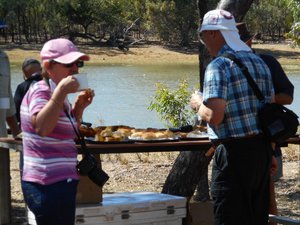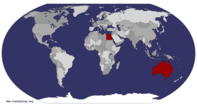Advertisement
Published: September 17th 2014

 Billy Tea and Damper
Billy Tea and Damper
Barry and other passengers enjoying the billy tea, damper and scones with jam and cream standing under the Coolibah Trees at the waterhole. We were given the tin mug with the Gulflander logo to keep as a memento.We were up early today for the Gulflander “Billy Tea and Damper Excursion”, a special run they do on Saturdays in the dry season. We’d been told not to eat anything as there was always heaps of food but it wasn’t coming until around 11ish so we had a light breakfast. We towed the van to the Station car park, which had plenty of room, and paid the fare (rather more than we had realised as you pay for the food – but it was worth it).
There were three carriages, the front having the diesel engine and driver in it and the back, where we went, had the guard with his brake wheel and other equipment plus all the water for the toilet. The carriages were built in 1950 to a 1937 design (must have been a good one!) and came to the Gulflander in 1982. The engine was a 6 cylinder Gardner Diesel engine that was 80 years old and still going strong. It had amazing economy, 53kms on 9 litres of fuel, which is why it was used here from 1921.
The Gulflander only ever ran between Normanton and Croydon and does the run once a

 The Gulflander at the Waterhole
The Gulflander at the Waterhole
We all got off the train and it sat there while we had our refreshments by the waterhole. Jeffrey, the Aboriginal guard on the train is checking all is OK.week – up to Croydon on Wednesday then back on Thursday. It was said to be going from “nowhere to nowhere” and has never been connected to the state rail network. It was originally built to connect the then bustling port of Normanton to the rich goldfields in Croydon. It was built between 1888 and 1891 and ran originally on steam and then the diesel, except in the wet season, of course. It runs on 3ft 6in gauge rails (still mostly the original ones) that were laid directly onto sleepers having a special design so they embed into the soil – it fills a cavity underneath them. This means it’s quicker (and lighter as the rails are shorter and the sleepers not solid) to lay as there is no ballast to put down and it doesn’t get affected so much by flood washing away the foundations. It is a bit more bumpy than a normal train track but we didn’t go too fast so it wasn’t a problem.
There was a fault in the last carriage so we had no PA system but as we were sitting right beside the Guard, (a young Aboriginal man named Jeffrey who had

 The View Leaving Normanton Station
The View Leaving Normanton Station
This was the view out of the rear guard's window looking towards the station and the edge of town. We are just crossing the Landsborough Highway, which is the bitumen you can see in the right hand corner.only been working on the train a few months and loved it) it wasn’t too much of a problem as he told us a few of the things we were passing. There were several waterholes which we could glimpse through the trees, and the river, which he told us was inhabited by a large Estuarine Crocodile named Norman. We didn’t see him, though.
We made a brief stop to drop off the tea supplies and continued on the Critters Camp (named by track workers for the variety of creepy crawlies they found while camped there, where the people from a bus tour got off to meet their coach – they missed out on the damper. With them gone, though, there was now room for us to move into the front carriage where we could hear the commentary by the driver and see the engine.
We then turned around and headed back to 11 Mile Waterholes, Chlorina, for our morning tea. It seems this was a popular place to picnic even in the early days and there had once been a community of around 20 people here, including some Chinese market gardeners. Unfortunately, it got washed away early in

 The One that Nearly Got Away
The One that Nearly Got Away
On the highway, we had to slow down drastically as the white steer on the left side of the road came running out of the scrub to our right and across in front of us, quickly pursued by the woman on horseback. She galloped along the road after it and steered it back towards the herd that was being mustered further along, but the little terror took off the other way again.the 20
th Century and was never re-established.
There were several tables set up, covered with plates of scones and damper (which looked more like buns but tasted good) and some savoury croissant. There was also a table with the jam and cream to put on them. There was so much food we kept eating for ages and didn’t clear the plates completely – we definitely won’t need lunch today!
Under one of the trees, the Billy Tea was being served in tin mugs, which we got to keep as a souvenir of the trip. He ran out and had to make another pot, which he filled with the tea leaves and boiling water and then swung around in a big vertical circle three times without losing the lid or spilling a drop. As it was just made there were rather a lot of tea leaves floating on top of our cuppa, but it tasted delicious and they slowly sank to the bottom as we drank it.
We stayed at the creek about 45 minutes eating, drinking and chatting with our fellow passengers, then it was back on the train for the run home. The driver kindly repeated

 Convoy!
Convoy!
This convoy of four three trailer road trains pulled into the Burke and Wills Roadhouse soon after we'd set up camp opposite. They were full of cattle, on two levels, that got very restless after about half an hour of sitting there while the drivers had a meal.some of the commentary he’d given on the way out as he realised a few of us had missed it. One of the things he said was that the 1974 flood had cut the town off for weeks and had gone as high as the floor of the Purple Pub and the ceiling of the Albion. Glad this is the dry!
It was interesting watching him drive – it looked more like driving a truck than a train and he kept the lid of the engine open so it was quite noisy. We made it back to Normanton Station at 12pm and then went to look at the little rail museum they had. Much of it was the usual kind of equipment you see in rail museums but we were struck by an old gravity fed fuel pump that had the cost per gallon as 25 cents and there was only enough space on the total sale cost for a maximum of $9.99! Those were the days.
As we came out of the museum, Barry spotted a Tawny Frogmouth up in the rafters of the station. The driver saw him pointing and said there was another, which we

 Goose-stepping Crow
Goose-stepping Crow
This crow obviously thinks he owns the Burke and Wills Roadhouse. He marched along the rail out the front, not at all worried by all the people around.found. They don’t blend in so well there as they do in trees but at least being so high up they were safe from other predators and people.
We then took the van to the Dump Point at the edge of town and emptied out, then set off at 1.30pm towards Burke and Wills Junction, where we planned to have a free camping night. Along the way we encountered a few strange sights. We had to avoid a heifer that came hurtling out of the scrub and crossed the road in front of us, quickly followed by a woman on horseback galloping full belt after it. She waved sorry and raced after it down the road. It evaded her and came back past us through the trees on the side of the road. Just past her we saw a large herd of cattle being mustered by several other stockpersons on horseback. This one had obviously got away!
Barry had chosen not to fill up with fuel at Normanton as it was very expensive. Maybe not the best decision, as we started to get an audible low fuel alarm. Barry decided we should have enough to make it to

 Tawny Frogmouth at Normanton
Tawny Frogmouth at Normanton
There were a pair of Tawny Frogmouths (a type of owl) nesting high in the rafters of the Normanton Station. When on a tree these birds are completely camouflaged, especially when they stand still with their head up. You can just see the "whiskers" above its beak.Burke and Wills Junction so we kept going. The alarm stopped once we were on the flat but came back about 10 kms down the road. I was getting really worried now and insisted that we stop and fill the tank from one of our spares in the back of the ute. While we were filling it, a few other RVers slowed down to check we were OK and didn’t need help, which we thought was very nice. On the whole, we all look after each other, which is very comforting.
We continued on our journey, without the alarm, thank goodness, and made it to Burke and Wills Junction at 4.15pm. Barry filled up the fuel tank (for $2.10 a litre which was worse than Normanton) and the spare and worked out that we had been down to a couple of litres and would not have made it without the top up. He won’t miss a fuel stop again!
I bought some delicious looking cakes from the Roadhouse, which we thoroughly enjoyed in the van with a well-deserved cup of coffee, after having set up in the open ground opposite the Roadhouse.
While we were 4 large triple tray Road Trains, all bearing the same logos, came into the parking area and went across for dinner. We decided that was a good idea and followed suit. It wasn’t as good as the cakes, though.
I went into the Ladies to wash my hands before the meal and was fascinated, and a little perturbed, to see signs both on the door and inside saying, “Keep Ladies Toilet door closed at all times as Brown Snakes like to visit – very often”. I was perturbed as the door was open. Fortunately, there were no visitors and I made sure I closed it when I left!
We had an early night after all our excitement today. We continue to Mt Isa tomorrow.
Advertisement
Tot: 0.141s; Tpl: 0.03s; cc: 11; qc: 29; dbt: 0.0352s; 1; m:domysql w:travelblog (10.17.0.13); sld: 1;
; mem: 1.1mb










